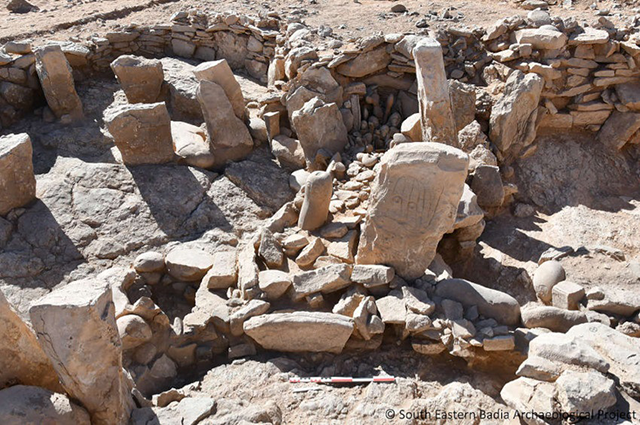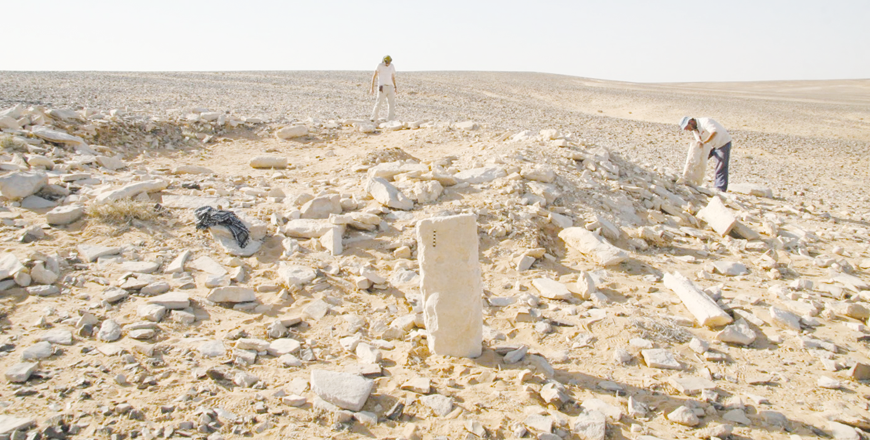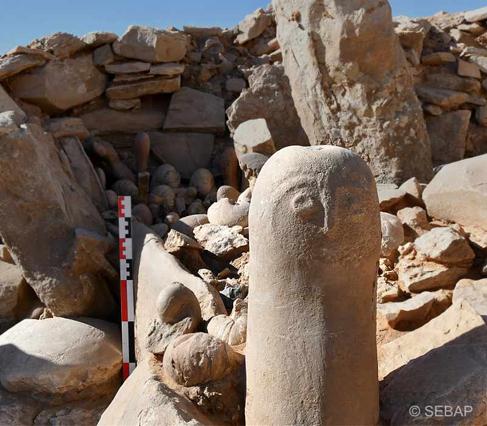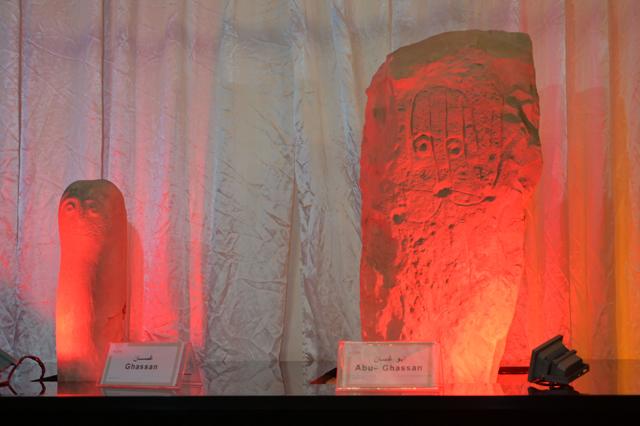You are here
South Eastern Badia: Unveiling Ghassanian occupation during Neolithic periods
By Saeb Rawashdeh - Feb 28,2024 - Last updated at Feb 28,2024

Carved stelae associated with a desert kite in Jibal Al Khashabiyeh represented a cultic site together with remains of standing figurines and fossils (Photo courtesy of SEBAP)
AMMAN — A research in the south-eastern desert began in 2013 when the “South Eastern Badia Archaeological Project” was established.
In a remote desert area of Jibal Al Khashabiyeh, archaeologists found a group of specific structures named “Desert kites”.
These structures were used for animal hunting and they spread from Hijaz to Biladi Sham and further north to Armenia and the Central Asia. The traps to capture gazelles were dated to the Late Pre-Pottery Neolithic B period (7,000BC), which is significantly earlier than previously thought for this kind of structures.
Another aspect of the projects’ results is the identification of the occupation sites related to the groups of hunters using the “Desert kites”.
These sites provide an invaluable amount of data related to the socioeconomic as well as the techno-cultural background of these Neolithic specialised hunters.
Recently, the excavation in two distinct Ghassanian occupation sites shed light on a hitherto unexpected aspect of this newly identified culture related to the ritual performance related to the use of “Desert kites”.
In 2021, a first exceptional ritual complex, including anthropomorphic standing steles and multiple symbolic and figurative references to the “Desert kite” was discovered and a new similar structure was uncovered during the last fieldwork season in 2023.
These structures are unique in view of their exceptional state of preservation and as they shed a totally new light on the symbolism, the artistic expression as well as the spiritual culture of the hunter populations involved in such mass hunting strategies during the Neolithic.
“What kind of occupation we had on this desert margine,” asked Mohammad Tarawneh at the lecture “Unveiling the Ghassanian Neolithic Hunters: Unprecedented Recent Discoveries from the South Eastern Badia Archaeological Project” held on Tuesday at ICOMOS headquarters in Jabel Luweibdeih. The presentation was organised by the Ifpo French Centre for the Middle Eastern Studies, French embassy and ICOMOS Jordan.
Lots of scientific research has been conducted in the Black Desert of the eastern Jordan, Tarawneh continued, adding that south-eastern Badia is the link between eastern and north-eastern parts of Jordan with Sinai.
The discovery of desert kites in Jibal Al Khashabiyeh was the first one of that kind, said Tarawneh, noting that circular structures that the team excavated were very well preserved.
“The kites were 2.5 metres deep which clearly pointed out to the hunting function of the structures,” Tarawneh said, noting that exploitation of gazelle in the area surpassed needs necessary for the local hunters so the surplus of meat was exchanged for other goods with neighbouring communities.
Ghassanians were a specific social group, they differed from sedentary communities in other parts of the region as they were professional hunters.
“Recently we made new discoveries that shed new light on unsuspected aspects of this operation, which are more related to ritual behaviour of those people,” noted Wael Abu-Azizeh from Ifpo, adding that the team found shrines in the sites.
Two anthropomorphic steles were found near the desert kites indicating the cultic use with many small sculptures as the deposit included around 270 artefacts
“Standing stones and marines fossils were placed in the same vertical position depicting a social group,” Abu-Azizeh speculated, adding that it is a symbolic representation of hunters, desert kites and the game.
Related Articles
AMMAN — Al Jafr is a town located near Maan, in the south-eastern region of Jordan, within the area of Jibal Khashabiyeh.
AMMAN — The Southeastern Badia Archaeological Project (SEBAP) focuses on late prehistory human developments in the arid margins of the so-ca
AMMAN — Minister of Tourism and Antiquities Nayef Al Fayez on Tuesday announced the discovery of a "unique ritual installation" dedicated to


















